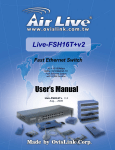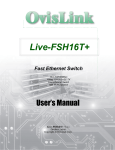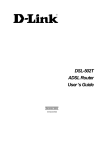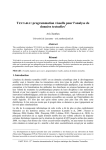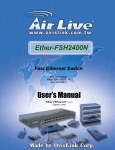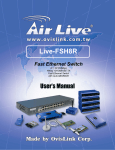Download User's Manual
Transcript
Live-FSH16T Live-FSH16T Live-FSH16T Live-FSH16T Live-FSH16T Live-FSH16T Live-FSH16T Live-FSH16T Live-FSH16T Live-FSH16T Live-FSH16T Live-FSH16T Live-FSH16T Live-FSH16T Live-FSH16T Live-FSH16T Live-FSH16T Live-FSH16T Live-FSH16T Live-FSH16T Live-FSH16T Live-FSH16T Live-FSH16T Live-FSH16T Live-FSH16T Live-FSH16T Live-FSH16T Live-FSH16T Live-FSH16T Live-FSH16T Live-FSH16T Live-FSH16T Live-FSH16T Live-FSH16T Fast Ethernet Switch 16 × 10/100Mbps + 1 × Uplink port NWay 10/100BASE-TX Fast Ethernet Switch with Priority Function User’s Manual Rev. Live-FSH16T V.1.0 Published: July 18, 2001 Copyright © OvisLink Corp. 1 Trademarks All rights reserved. OvisLink and OvisLink Logo are registered trademarks of OvisLink Corp. Other product and company names trademarks or registered trademarks of their respective companies. Contents in this manual are subject to changes without prior notice. FCC Warning This equipment has been tested and found to comply with the requirements for a Class A digital device, pursuant to Part 15 of the FCC Rules. These requirements are designed for reasonable protection against harmful interference when the equipment operating in a commercial environment. This equipment can generate and radiate electromagnetic energy and, if not installed and used in accordance with this guide, may cause significant interference with radio communication. Operation of this equipment in a residential area is likely to cause interference to household appliances, in which case the user will be required to amend at his or her own expense. CE Mark Warning This is a Class A product. In a domestic environment, this product may cause radio interference, in which case the user may be required to take adequate preventive measures. 2 About this User’ User’s Manual This User’s Manual aims at helping users to know the key features of Live-FSH16T Fast Ethernet Switch and to install it in a 10/100BASE-TX Fast Ethernet Local Area Network (LAN). 3 Table of Contents PRODUCT OVERVIEW ........................................................................ 8 Introduction ....................................................................................................................... 8 16-port 10/100 Mbps Fast Ethernet Switch..................................................................... 8 Easy Plug-and-Play ......................................................................................................... 8 Cost-effective for LAN Users ......................................................................................... 8 Store-and-Forward Architecture against Packet Loss..................................................... 9 Active Flow Control........................................................................................................ 9 Port Status Information at a Glance ................................................................................ 9 What is 10/100 Mbps Dual-Speed Switching? ................................................................ 9 What is Priority Queuing? ............................................................................................. 10 Product Features ............................................................................................................. 11 PREPARATION BEFORE INSTALLATION .............................. 12 Unpack the Package ........................................................................................................ 12 The Front Panel............................................................................................................... 13 The Rear Panel ................................................................................................................ 13 Station Ports (Port #1 to #16)........................................................................................ 13 Uplink Port .................................................................................................................... 14 DC Power Jack .............................................................................................................. 14 4 INSTALLATION OF THE SWITCH............................................ 15 Quick Installation............................................................................................................ 15 3 Steps to Quick Installation ......................................................................................... 15 Installation Site Preparation .......................................................................................... 16 Desktop Installation ........................................................................................................ 16 Installation on Wall......................................................................................................... 17 Cabling Requirements .................................................................................................... 17 RJ-45 station port cable requirements........................................................................... 18 Other 10/100BASE-T/TX twisted-pair cable requirement ........................................... 18 Connecting to power ....................................................................................................... 19 EXPANDING YOUR NETWORK ........................................................ 21 Connectivity Rules........................................................................................................... 21 10 Mbps Connection ..................................................................................................... 21 100 Mbps Connection ................................................................................................... 21 Hub-to-Switch connection .............................................................................................. 22 Switch-to-switch Connection.......................................................................................... 22 Using a Straight Cable................................................................................................... 22 Using a Crossover Cable ............................................................................................... 23 RJ-45 Port Description.................................................................................................. 23 Summary ....................................................................................................................... 24 Transmission Mode ......................................................................................................... 24 Using Priority Ports ........................................................................................................ 25 Applications ..................................................................................................................... 25 LAN Microsegmentation............................................................................................... 25 Easy Migration to Workgroup Computing.................................................................... 26 5 Priority Queuing............................................................................................................ 27 LED INDICATORS.............................................................................. 28 Power LED....................................................................................................................... 28 Station-port LEDs ........................................................................................................... 28 Link/Rx LED................................................................................................................. 28 FDX/Col LEDs.............................................................................................................. 29 100 M LED.................................................................................................................... 29 APPENDIX A ..................................................................................................... 30 Product Specifications..................................................................................................... 30 APPENDIX B ..................................................................................................... 32 Troubleshooting............................................................................................................... 32 Tables Table 3-1: Using straight-through and crossover cables............................................... 18 Table 5-1: LED signals ................................................................................................. 29 Figures Fig. 2-1 Package Contents............................................................................................. 12 Fig. 2-2 Front Panel...................................................................................................... 13 Fig. 2-3 Front Panel...................................................................................................... 13 Fig. 3-1 Quick Installation ............................................................................................ 15 Fig. 3-2 Desktop installation ......................................................................................... 16 Fig. 3-3 Bottom View of the Switch (showing mounting holes) .................................. 17 Fig. 3-4 RJ-45 connector pin assignments .................................................................... 19 Fig. 3-5 Pin assignments for straight-through cabling ................................................. 19 Fig. 3-6 Connecting the Switch to power outlet............................................................ 20 6 Fig. 4-1 Connection through Uplink Port using straight-through cable ..................... 22 Fig. 4-2 Connection through Station Port using crossover cable................................ 23 Fig. 4-3 Pin assignments for crossover cabling............................................................. 24 Fig. 4-4 Wire schematics for straight-through and crossover cable............................. 24 Fig. 4-5 Microsegmentation in a LAN group................................................................ 26 Fig. 5-1 LED indicators................................................................................................. 28 7 Product Overview Introduction 16-port 10/100 Mbps Fast Ethernet Switch Live-FSH16T Fast Ethernet Switch is a 16-port auto-sensing and auto-negotiating Dual-speed Fast Ethernet Switch with Port Priority function. All of its 16 RJ-45 station ports support Dual Speed with auto-sensing and auto-negotiating functions. All 16 station ports can automatically adapt to data rates ranging from 10 Mbps (Ethernet half-duplex mode) to 200 Mbps (Fast Ethernet full-duplex mode). Live-FSH16T also features port priority function that is implemented via built in priority port (port 5, 6, 7 and 8). You can instantly utilize priority function by plugging into these ports without further configuration. Priority port can ensure high priority traffic to be delivered efficiently, even when during bursts of high traffic load. Traffic such as voice data and video (services which are streaming) are thus prioritized, helping steady picture and sound quality. Please refer to the Using Priority Ports section in Chapter 4. The Uplink port is provided for connection with another switch with straight-through cable. With its Uplink port, you can connect two switches together to reach a maximum of 48 ports. With auto-sensing function, Live-FSH16T Fast Ethernet Switch automatically detects the speed of the devices you plug into, and routes the incoming data to its destination. Its auto-negotiating function also allows existing devices with different speeds to communicate easily within the same network. With these advantages, you have no further costs for hardware investment in unnecessary or expensive upgrade. Easy Plug-and-Play Live-FSH16T Fast Ethernet Switch fully complies with the IEEE802.3 standard for 10BASE-T network and the IEEE802.3u standard for 100BASE-TX network. And it takes users almost no effort to install. Simply plug in the power and connect devices to its ports and you just complete its installation. With its easy Plug-and-Play installation procedure, Live-FSH16T Fast Ethernet Switch costs you virtually no effort to install and run. Cost-effective for LAN Users Live-FSH16T Fast Ethernet Switch is your best choice for a cost-effective solution to 8 expand, connect or upgrade your existing 10 Mbps Ethernet to 100 Mbps Fast Ethernet network. With the implementation of Live-FSH16T Fast Ethernet Switch, it means that your existing 10 Mbps Ethernet network can be extended to Fast Ethernet 100 Mbps speed at very effective costs. Store-and-Forward Architecture against Packet Loss It is recognized that when network is under heavy traffic, the shared memory buffer in the switching devices might yield incorrect detections due to an overfed memory buffer. This drawback in transmission can happen either when data being transmitted in IEEE802.3x Full Duplex or Back Pressure Flow Control mode. To amend this problem, Live-FSH16T Fast Ethernet Switch utilizes a fixed memory buffer allocation with Store-and-forward transmission to ensure an effective buffer allocation for each port. Store-and-forward transmission controls data flow from transmitting to receiving nodes with the receiving buffer threshold adjusted to optimal value, guaranteeing against all possible packet losses. Active Flow Control Live-FSH16T Fast Ethernet Switch implements in full duplex mode a flow control which is compliant to IEEE 802.3x standard. While in half duplex mode, it employs an optional Back Pressure Flow Control to stall the incoming data when port buffers being saturated. With this flow control mechanism, it can be ensured that frames dropped during transmission are reduced to a minimum. Port Status Information at a Glance The LED indicators on the front panel show relevant information of your network status. Power LED indicates the Power On/Off status. Each Link/Rx LED indicates the linking and receiving status of each port, while FDX/Col LED shows the half-duplex/full-duplex transmission status and collisions within network. 100 M LED indicates the connection is running at 100 Mbps mode. For detailed LED information, please refer to Chapter 5, LED indicators. What is 10/100 Mbps Dual-Speed Switching? Current expansion of multimedia usage on the network, together with the new wave of distributed Client/Server applications, creates a much higher demand for bandwidth and tighter integration of clients and servers. The legacy shared-access 10Mbps Ethernet technology can no longer provide adequate bandwidth and predictable response time to the new workgroup environment. 10/100 Switching is an integral extension of Fast Ethernet. It provides not only the 100Mbps high-speed “pipeline” for carrying aggregated 10Mbps traffic, but also the necessary bridging between the 10BASET and 100BASE-T MAC formats. Fast Ethernet combined with the Switching technology offers an adequate bandwidth to satisfy the demand of local workgroups. It also provides a high-speed link to carry local network traffic elsewhere within a network. Ethernet switching technology dramatically boosts the total bandwidth performance of a LAN network. It also furnishes configuration 9 flexibility and bandwidth adaptability for the local workgroups where the majority of workload is generated by business applications. Switching function further eliminates the congestion problem inherent to the contention-based CSMA/CD protocol, thereby improving predictable response time under heavy load. While in the past, this network congestion could only be alleviated by much more expensive routing technology. With the implementation of switching technology, Live-FSH16T Fast Ethernet Switch is your perfect solution to solve network congestion. What is Priority Queuing? Priority Queuing is a method of ensuring that high priority traffic gets delivered efficiently, even when during bursts of high traffic load. In this way, traffic such as voice data and video (services which are streaming) are prioritized, helping steady picture and sound quality. If you have any plans to implement network telephony or any sort of video conferencing, streaming video/audio or any real-time applications on your network you will need Live-FSH16T for priority queuing. The benefit of priority queuing is that it can dramatically improve the quality of priority services on the network. If priority queuing is not implemented then the quality of these services will depend entirely on the load on your network. If network traffic is high, the service will not work properly. 10 Product Features The main features of Live-FSH16T Fast Ethernet Switch are as follows: Ideal for workgroup environment in Fast Ethernet network Easy migration from existing 10 Mbps Ethernet network to 100 Mbps Fast Ethernet network Cost-effective to connect and expand your existing 10 Mbps Ethernet network to 100 Mbps Fast Ethernet networking environment Easy installation without further maintenance costs Plug-and-play function saving network management efforts Best Choice to protect your previous network hardware investment Full compatibility with Standard and Fast Ethernet: - IEEE 802.3u (100 BASE-TX Fast Ethernet) - IEEE 802.3 (10 BASE-T Ethernet) - IEEE 802.1p Class of Service (Priority Queuing) - ANSI/IEEE Std 802.3 Nway auto-negotiation Flexible port configuration: - 16 × 10/100 Mbps auto-sensing and auto-negotiating ports - 1 × Uplink Port Store and Forward transmission to prevent packet loss Priority ports: Port 5, 6, 7 and 8 Prioritization sources: Port-based Priority Priority level: High/Normal Store and Forward transmission to prevent packet loss Half/Full Duplex function for all stations ports and Uplink port Auto-sensing and auto-negotiating function for all station ports and Uplink port Active Flow control to minimize frame drops - Half Duplex: Back Pressure control - Full Duplex: IEEE 802.3x compliant flow control LED indicators for port status monitoring: - Power LED (green) to indicate power on/off status - Link/Rx (green) to indicate Linking status and activity - FDX/Col (yellow) to indicate Full/half duplex transmission mode and collisions - 100 M LED (red) to indicate 10/100 Mbps speed Cabling distance between switches extensible to 100 meters through the Uplink port (shared with port 16) 11 Preparation before Installation Unpack the Package Before you begin the installation of Live-FSH16T Fast Ethernet Switch, make sure that you have all the necessary components that come with your package. Follow the steps below to unpack your package contents: Step 1. Clear out the surrounding area for an adequate space to unpack the package carton. Step 2. Open the shipping carton and take out the package contents carefully. Step 3. Put back all the shipping materials such as plastic bag, paddings and linings into the shipping carton and save them for possible future transport need. After unpacking and taking out all the components, you should check your package contents to see if you’ve got all the following items: Live-FSH16T Fast Ethernet Switch One DC power Adapter Wall-mounting kit (screws and wall-anchors) This User’s Manual (can be found on Support CD-ROM) Quick Start Guide If any of these components is missing or damaged, please contact your local dealer for replacement. Fig. 2-1 Package Contents 12 The Front Panel The front panel is where you can find the LED indicators. For information concerning LED indicators, please refer to Chapter 5, LED Indicators. LED Indicators Fig. 2-2 Front Panel The Rear Panel The rear panel is where you can locate the DC power jack, the 16 10/100Mbps station ports and 1 Uplink port. For the technical specifications of the ports, please refer to Product Specifications in Appendix A, Product Specification for detailed information. DC Power Jack Station Ports Station Ports Priority ports: port 5, 6, 7 and 8 Fig. 2-3 Front Panel Station Ports (Port #1 to #16) Live-FSH16T Fast Ethernet Switch is equipped with 16 10/100Mbps auto-sensing and auto-negotiating ports. You can use these ports to connect to end stations, servers or other networking devices. 13 Uplink Port The Uplink port allows connection to another hub, switch or other network device using a straight-through cable. DC Power Jack The DC Power Jack is where you should connect the DC power adapter chord. 14 Installation of the Switch Quick Installation Live-FSH16T Fast Ethernet Switch is compliant to both 10BASE-T Ethernet and 100BASE-TX Fast Ethernet standards. It also provides an Uplink port to extend your switch-to-switch cabling distance to 100 meters. Live-FSH16T Fast Ethernet Switch is primarily targeted as an ideal solution to enhance your workgroup performance in an Ethernet/Fast Ethernet network. 3 Steps to Quick Installation Step 1. Prepare the network devices you wish to setup a network. Step 2. Check visually the integrity of the power cord to see if it is in good condition. If the power cord is ready for use, then plug the female end of the power cord into the connector on the rear of the switch, and the male end into a power outlet. Step 3. Connect your network devices (e.g., workstation, server, switch, bridge or router) to the RJ-45 port (10/100BASE Fast Ethernet), using a 100 unshielded twisted pair (UTP Cat 3,4 or 5) or shielded twisted-pair (STP) cable. Fig. 3-1 Quick Installation 15 Installation Site Preparation You can mount Live-FSH16T Fast Ethernet Switch either on a table or on wall. If you plan to mount the switch on the table, please choose a steady, level surface in a well-ventilated area that is free from excessive dust. In any case, the installation site chosen for your switch has to comply with the following requirements: The surface to mount the switch must be able to sustain the weight of the switch. Do not place heavy objects on top of the switch. The location must preferably be free from excessive dust, away from heat vent or other warm-air exhaust and direct sunlight. The switch should not be placed near large electric motors or other electromagnetic equipments. As a reference, the strength of the electromagnetic field on site should not exceed the (RFC) standards for IEC 801-3, Level 2 (3V/M) field strength. The air temperature in the location should be within a range of 32 to 122 ° F (0 to 55 °C). The relative humidity in the location should not exceed 95% non-condensing humidity. The power outlet should be located within 6 feet from the device. The distance between the RJ-45 port and the standard network interface should not exceed 100 meters. Adequate space should be allowed in front of all the ports, so that each port is easily accessible for cable connections. Desktop Installation Live-FSH16T Fast Ethernet Switch has four rubber pads attached on each corner of its underside. These pads serve as cushioning against vibration and prevent the switch from sliding off its position. They also allow adequate ventilation space when you place the switch on top of another device. Fig. 3-2 Desktop installation The location you choose to install your switch and the way you configure your network may greatly affect its performance. The following sections will provides you with a step-by-step reference to the following networking requirements: 16 Installation site preparation Cabling requirements Connecting to power Installation on Wall Live-FSH16T Fast Ethernet Switch can be mounted on a wall with wall anchors and screws. To mount the Switch on wall, please follow the steps below: Drill two holes, the distance between both of which should be 9 cm (such as the illustration below). Insert wall anchors into these two holes. Drive the screws into the top of the wall anchors. Mount Live-FSH16T on the screws. 9 cm Fig. 3-3 Bottom View of the Switch (showing mounting holes) Cabling Requirements Live-FSH16T Fast Ethernet Switch is primarily targeted as a switching device to concentrate your network traffic in a workgroup environment. It fits well into the 10BASE-T and 100BASE-TX cabling architecture to facilitate UTP end-station connections to 10BASE-T/100BASE-TX network. The Uplink port also provides a switch-to-switch cabling extension up to 100 meters. The 16 RJ-45 station ports (MDI-X), which require either UTP or STP cable connection, is compliant with 10/100 BASE Fast Ethernet standard. Thus, when configuring within the 10BASE-T/100BASETX cabling architecture, the UTP cabling distance should be within a maximum distance of 100m. 17 RJ-45 station port cable requirements 10BASE-T 100 ohm Category 3,4 or 5 unshielded or shielded (UTP/STP) twisted-pair cables. 100BASE-TX 100 ohm Category 5 unshielded or unshielded twisted-pair (UTP/STP) cables. Other 10/100BASE-T/TX twisted-pair cable requirement Under most conditions, the 16 station ports on the Switch may accept normal, straight-through cables, i.e., standard UTP cables, which are the only ones that can be used with a RJ-45 pin layout. In some circumstances, however, crossover cables may be required -- if a cable is used for a hub or switch connection, the transmit (TD) and receive (RD) leads to one end of the connectors must be reversed or connected to the uplink port on another hub or switch. The table below describes what types of cable should be used in certain circumstances: Connection Specification Interface Cable to Use To an end station To a hub/switch Maximum Distance Station Port 10BASE-T/100BASE-T Uplink Port 10BASE-T/100BASE-T RJ-45 RJ-45 Straight-through -twisted-pair cable Crossover twisted-pair Straight-through cable twisted-pair cable 100 meters 100 meters Table 3-1: Using straight-through and crossover cables 10/100BASE-T/TX networks require a 4-pair, data grade UTP/STP cabling system. The cabling system could be found in most existing network installations. The pin assignments for a straight-through cable are shown in Figures 3-4 and 3-5. 18 Fig. 3-4 RJ-45 connector pin assignments Fig. 3-5 Pin assignments for straight-through cabling Connecting to power Live-FSH16T is accompanied with an external power adapter unit, which is specifically designed for the line voltage and the type of AC outlet used in your location. This power adapter provides the voltage, amperage, and polarity required by the Switch (7.5VDC@2A, inside positive, outside negative) and is outfitted with the correct type of barrel connector for the DC power jack on the rear panel. After verifying that the DC power adapter cord is suitable for use, just plug the male end of the DC power adapter into a power outlet on the wall; and plug the barrel connector of the power adapter into DC power jack on the Switch. Once you have correctly plugged in the power, the Switch is activated. 19 Fig. 3-6 Connecting the Switch to power outlet 20 Expanding Your Network Live-FSH16T Fast Ethernet Switch is primarily targeted not only as a concentrator to converge workgroup traffic within Ethernet/Fast Ethernet; but also as a central switching device to send incoming data to its destination LAN segment. With your existing Ethernet/Fast Ethernet infrastructure, you can very easily connect, expand or migrate to workgroup computing in an Ethernet/Fast Ethernet environment. The following sections will introduce to you the basics of network connectivity in workgroup computing within Ethernet/Fast Ethernet environment. Connectivity Rules 10 Mbps Connection Ethernet (10Mbps) networks should be configured according to the following connectivity rules: The maximum length for UTP cables must not exceed 100 meters from end station to a shared-access 10BASE-T hub. Between any two end stations in a collision domain, there may be up to five cable segments and four intermediate repeaters at most. If there is a path between any two end-stations containing five segments and four repeaters, then at least two of the cable segments must be point-to-point link segments (e.g. 10BASE-T, 10BASE-5), while the remaining segments may be of mixed segments (e.g.: 10BASE-2 or 10BASE-5). 100 Mbps Connection Fast Ethernet (100Mbps) network should be configured according to the following connectivity rules: The maximum length for UTP cables is 100 meters from end station and a shared-access 100BASE-TX hub. The maximum cabling length is 100 meters between end station and switch/repeater; and 100 meters between switch and switch/repeater, thus making possible a maximum distance of 300 meters between two end stations. 21 Hub-to-Switch connection Live-FSH16T Fast Ethernet Switch allows a 10BASE-T or 100BASE-TX hub to be connected to the Switch via a 4 –pair UTP / STP straight cable (Category 3, 4 or 5). Each cable length can be up to 100 meters long (328 feet). The hub-to-switch connection is made through the Uplink daisy-chain port (MDIII) on the hub to any of the station ports (MDI-X) on the Switch. For a 10BASE-T or 100BASE-TX hub, the LED indicators on the Switch should give the following signals to indicate a proper and functional connection: Link/Rx LED indicator should be ON 100 M LED indicator should be ON if connected to 100BASE-TX, otherwise it should be OFF Note: Both 10BASE-T and 100BASE-TX network environments allow uplinking, but each follows different rules for connection. Switch-to-switch Connection Live-FSH16T Fast Ethernet Switch can be connected to another switch or other device such as a router or bridge by a two-pair UTP / STP Straight or Crossover cable (Category 3, 4, 5). Using a Straight Cable When using a straight cable, the switch-to-switch connection is done through the Uplink daisy-chain port (MDI-II) of the Switch to any of the 10Mbps or 100Mbps station port (MDI-X) of another switch or device. Fig. 4-1 Connection through Uplink Port using straight-through cable 22 Using a Crossover Cable When connecting any 10/100 Mbps station port (MDI-X) of other switch or device with any station port (MDI-X) of Live-FSH16T Fast Ethernet Switch, it is required that you use a crossover cable. Fig. 4-2 Connection through Station Port using crossover cable The LED indicators on Live-FSH16T Fast Ethernet Switch corresponding to the respective connected port should give the following signals to indicate a proper and functional connection: Link/Rx indicators should be ON 100M LED is ON for a 100BASE-TX connection; otherwise it is OFF FDX/Col LED status will depends on the status of the other connected switch or device Note: Do not plug a phone jack connector into any RJ-45 port. This may damage the port. Instead, use only twisted-pair cable with RJ-45 connector that conforms with FCC standards. Note: Port 16 is shared with the Uplink daisy-chain port, although their pinouts are different. Do not use both port 16 and the Uplink Port (MDI-II) at the same time. Note: Make sure each twisted-pair cable does not exceed 100 meters. To connect to another switch or hub, you may make a connection with station ports (MDI-X) at both ends if you use crossover cable. RJ-45 Port Description RJ-45 station ports (MDI-X) can be attached to any devices, which use a standard network interface (e.g., a workstation, server, bridge or router). But the Uplink daisy-chain port (MDI-II) can be cascaded to a station port on similar networking devices (e.g. another 23 switch or hub). When cascading multiple switches (or hubs), it is important that the UTP cables should be of crossed-over type as shown in the diagram above. Also, make sure you use the same pair of wire for pin pairs 1-2, 3-6,4-5 and 7-8. Fig. 4-3 Pin assignments for crossover cabling The wire schematics for both straight-through and crossover twisted-pair cables are shown as below: Fig. 4-4 Wire schematics for straight-through and crossover cable. Summary When connecting a computer to a switch, use a straight UTP cable. When connecting Live-FSH16T to any station port (MDI-X) of another hub via its Uplink port (MDI-II), use a straight-through UTP cable. Please note that the cabling distance is 100 meters maximum. When using crossover cable, the connection can be made from any station ports (MDI-X) of Live-FSH16T to any station ports (MDI-X) of other devices. Transmission Mode All 10/100Mbps ports of Live-FSH16T Fast Ethernet Switch utilize auto-negotiation to determine the transmission mode for any new connection. This means, if auto-negotiation is supported on both ends of the connection, the Switch is initiated to negotiate for one of the following transmission modes: 200Mbps/FDX 100Mbps/HDX 20Mbps/FDX 24 10Mbps/HDX Using Priority Ports If you regularly use video/multimedia application on your LAN, you can maximize on the Priority Queuing function the Live-FSH16T. Specifically, the priority ports are port 5, 6, 7 and 8 and they are built-in and without the need of any configuration. Using these priority ports can ensure high priority traffic gets delivered efficiently, even when during bursts of high traffic load. Traffic such as voice data and video (services which are streaming) are prioritized, helping steady picture and sound quality. To utilize prioritized traffic, just connect network devices that is dedicated to voice/video/multimedia applications to a priority port (either port 5, 6, 7 or 8) The priority level is set to High as compared to Normal (non-priority) level of the other ports. Applications LAN Microsegmentation In addition to workgroup performance improvement, Live-FSH16T Fast Ethernet Switch can also effectively segment your network, significantly increasing both bandwidth and throughput. Any port on the Switch can either be attached to a hub (i.e., shared collision domain) or serve as a dedicated link to a single network device (e.g., a workstation). When a port on the Switch is connected to an Ethernet hub (i.e., a 10 or 100 Mbps repeater), the bandwidth provided by that port is shared by all the devices connected to the attached hub. However, when a port is connected to an end node or to a device that breaks up the collision domain (e.g., another Switch, bridge or router), the attached device has access to the full bandwidth provided by that port. Microsegmentation of an existing LAN can improve network latency and increase overall performance. Live-FSH16T Fast Ethernet Switch uses Store-and-Forward switching to direct network traffic, thus ensuring data integrity under heavy load. Figure 4 -4 shows an example of microsegmentation of the 10/100 BASE Fast Ethernet workgroup environment. With such a versatility and flexibility plus a very cost-effective and easy installation, you will appreciate Live-FSH16T as your best choice for migrating to workgroup computing. For details on the cabling requirements, please refer to Chapter 3 and 4. 25 Fig. 4-5 Microsegmentation in a LAN group Easy Migration to Workgroup Computing Live-FSH16T Fast Ethernet Switch serves primarily as a concentrator to converge your workgroup traffic, and as a highly efficient switching device to forward the incoming data to destination network segments. With its auto-sensing and negotiating functions, it makes your mixed Ethernet/Fast Ethernet networking environment as efficient and compatible. Not only can you expand or upgrade to 100 Mbps bandwidth of Fast Ethernet without virtually no effort, but also your existing Ethernet hardware investment are saved for your leverage. It is a perfect solution to cater to your network expansion needs. With its Uplink Port, Live-FSH16T is also extremely flexible in network configuration. Through uplinking multiple switches, hubs or other devices, plenty of flexibility and expandability is left for the network administrator to apply in future LAN configuration and expansion. Whether you have just set up your Ethernet/Fast Ethernet environment or you have already got an existing Ethernet network, Live-FSH16T Fast Ethernet Switch is your best choice for gaining the benefits and resources of workgroup computing. Since Live-FSH16T Fast Ethernet Switch provides such a cost-effective way to gear up your network performance toward workgroup computing, you will appreciate the easy plug-and-play function of its installation within your network. In fact, we can envision a workgroup environment as complex as what is shown in Fig. 4-5. Often challenged with a heavy traffic load generated by workgroup applications, you need a device such as Live-FSH16T to act as a concentrator and central switching device to take care of the traffic flow. With its 16-port capacity, it can adopt as many end stations and servers or even connect to other network devices. Through uplinking and cascading with other devices, you can even expand this capacity in a very easy and cost-effective way. 26 Fully compatible with either 10/100 Mbps connection in either half/full duplex transmission mode, Live-FSH16T can easily connect devices with different transmission speeds. With 100 Mbps providing a much higher bandwidth than standard 10 Mbps Ethernet, you can rely on Live-FSH16T to serve as an effective switching device to connect client computers to server or even a server farm. Priority Queuing Live-FSH16T is equipped with the Priority Queuing function for port 5, 6, 7 and 8. Priority port can ensure high priority traffic to be delivered efficiently, even when during bursts of high traffic load. Traffic such as voice data and video (services which are streaming) are thus prioritized, helping steady picture and sound quality. If you have any plans to implement network telephony or any sort of video conferencing, streaming video/audio or any real-time applications on your network you will need Live-FSH16T for priority queuing. The benefit of priority queuing is that it can dramatically improve the quality of priority services on the network. If priority queuing is not implemented then the quality of these services will depend entirely on the load on your network. If network traffic is high, the service will not work properly. 27 LED Indicators The front-panel LED indicators enable users of Live-FSH16T Fast Ethernet Switch to monitor the Power On/Off status of the Switch and the port status of each of its sixteen 10/100 Mbps station ports. For the layout of LED indicators, please refer to Fig. 5-1 below. As seen on Fig. 5-1, Power LED indicates the power on/off status of the switch. For each station port, there are Link/Rx (Link/Activity), FDX/Col (Full-duplex/ Collision) and 100M LED to indicate its corresponding port status. You’ll find the LED indicators to be a very convenient way for hub or port status monitoring and troubleshooting. Before connecting any network device to Live-FSH16T Fast Ethernet Switch, you should take a few minutes to look over this section and get familiar with the front panel LED indicators of your Switch. Fig. 5-1 LED indicators Power LED Power LED will give a solid green light when you turn on the Switch, and will be off when the Switch being turned off. You can simply check the Power LED status to see if the Switch is being activated or not. Before turning on the Switch, please verify that the power cord has been properly connected the Switch to the power outlet on the wall. Station-port LEDs Link/Rx LED Link/Rx LED giving a solid green light indicates that a data link has been established between the corresponding port and the device. If the connection is faulty, it will be off. 28 While the port is transmitting or receiving data, you will see a blinking green light. If you’ve made a connection but the Link/Rx LED does not light up as expected, you should check whether the RJ-45 connectors are damaged, or the cable type or pin-out is not correct, or the cable length exceeds the 100 meter limit. FDX/Col LEDs FDX/Col LED shows the transmission mode as well as the presence of collision on the network. When in full-duplex transmission mode, FDX/Col LED gives forth a solid yellow light. When in half-duplex mode, it will be off. But, when in half-duplex mode, there are two or more end stations on the same network segment attempting to transmit data at the same time, a collision occurs. If there is a collision detected on specific network segment, the corresponding FDX/Col LED shows a blinking yellow light. When a collision occurs, all of the stations involved will recognize the collision, wait a random amount of time, and retransmit. FDX/Col LED status is summarized as follows: ON : Transmission in full-duplex. OFF: Transmission in half-duplex. Blinking: Collision detected. 100 M LED 100M LED showing a solid red light indicates that the line speed going through that specific 10/100 Mbps port is operating at 100Mbps mode. If the transmission speed operates only at 10 Mbps, it is off. A summary of the station-port LED status is listed in Table 5-1 below: LED indicator Color Status Meaning System LEDs Power LED ● Green ON OFF Power ON Power OFF Station Port LEDs Link/Rx ● Green ON Blinking OFF ON Blinking OFF ON OFF Connection is made Transmitting/Receiving No connection is made Full Duplex Collision (in half duplex) Half Duplex 100Mbps speed 10Mbps speed FDX/Col ● Yellow 100M ● Red Table 5-1: LED signals 29 Appendix A Product Specifications Standard Compliance IEEE 802.3 10BASE-T Ethernet IEEE 802.3u 100BASE-TX Fast Ethernet IEEE 802.1p Class of Service (Priority queuing) ANSI/IEEE Std 802.3 Nway auto-Negotiation IEEE 802.3 Frame Type Topology Star Protocol CSMA/CD Port Configuration 16 × 100 BASE-TX Ports 1 × Uplink Port Priority Ports Port 5, 6, 7 and 8 Prioritization Sources Port-based Priority Priority Level High/Normal Data Rate Ethernet 10 Megabit/sec (half-duplex) 20 Megabit/sec (full-duplex) Fast Ethernet 100 Megabit/sec (half-duplex) 200 Megabit/sec (full-duplex) Transmission method Store and Forward Full Duplex Auto-negotiation RAM Buffer 512 Kbytes per device Active Flow Control IEEE 802.3x compliant flow control for full duplex Back Pressure option for half duplex Filtering Address Table 16 K per device Packet Filtering/Forwarding rate Wire speed for 10/100 Mbps 30 MAC Address Learning Automatic update Cabling Type 100BASE-TX 4-pair 100 ohm Category 5 UTP or STP (100 m) cable 10BASE-T 4-pair 100 ohm Category 3,4,5 UTP(100 m) cable Cabling distance 100 meters for switch-to-repeater connection 100 meters for switch-to-station LED layout System Status LEDs Power LED Station port LEDs Link/Rx LEDs FDX/Col LEDs 100 M LEDs Dimensions 209 × 144 × 49 m/m Net Weight 600 g Power Input External Power Supply with + 7.5 VDC@ 2A output Power Consumption 45 Watts max, @ 100 ~ 240 V AC Operating Temperature 32 ~ 122 °F / 0 ~ 50 °C Storage Temperature - 40 ~ 149 °F / -40 ~ 65 °C Humidity < 95% (non-condensing) Safety / EMI Certificates FCC Class A, CE mark 31 Appendix B Troubleshooting This appendix contains information to help you identify and solve problems. If your switch does not function properly, please make sure it is set up according to the instructions on the manual. If you suspect your switch is not connected correctly to your network, check the following points before you contact your local dealer for support. Make sure that the maximum cable length between switch and end node does not exceed 100 m Make sure that the maximum switch-to-repeater cable distance does not exceed 100 meters Verify that the cabling type used is correct (Category 5 UTP) Check the Link/Rx LED lights on the front panel to see if it lights up. If it does not light up, that means a faulty connection. Check the status of the cable attachment. If the problem persists, try a different cable. Try another port on the Switch. Turn off power supply to the Switch. After a while, turn it on again to see if it resumes to its normal function. If you find out where the problem is but can not solve it by yourself, or you simply cannot locate what is at fault, please contact your local dealer for technical support. 32
































